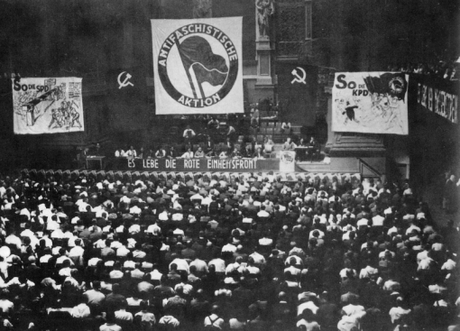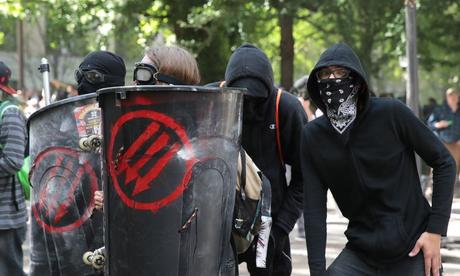
Antifa Conference, Berlin, 1932
I’ve been studying some history of the Bolshevik Revolution in the early 20th Century. Now reading “Red Victory”, a very well documented account beginning in 1917 with the “February Revolution” followed by “Red Oktober” which developed into Lenin’s “Red Terror” policy.
It seems that Karl Marx’s Utopian ideal of “no borders” and “no economic classes”, where the collective holds “all property in common” and all labor is organized for the “common interest”, cannot be obtained, even according to Vladimir Lenin, except by the Revolution using the power of the state enforced by the gun through tyranny.
Communist revolutions around the world have all come to that same conclusion, that Marx’s Utopia which eliminates war is only attainable through terrorizing and eliminating their opposition. Classic information paradox.
Then you have Fascism… and National Socialism.
These two are hard to differentiate, and in all practicality, when allowed to play out, all 3 systems result in almost the same death, destruction, and dehumanization of it’s opposition. Practical definitions are as follows:
Communism:
a. A system of government in which the state plans and controls the economy and a single, often authoritarian party holds power, claiming to make progress toward a higher social order in which all goods are equally shared by the people.
b. The Marxist-Leninist doctrine advocating revolution to overthrow the capitalist system and establish a dictatorship of the proletariat that will eventually evolve into a perfectly egalitarian and communal society.
Fascism:
2. a system of government characterized by rigid one-party dictatorship, forcible suppression of opposition, private economic enterprise under centralized governmental control, belligerent nationalism, racism, and militarism, etc.
Nazism (National Socialism):
The ideology and practice of the Nazis, especially the policy of racist nationalism, national expansion, and state control of the economy.
1. The ideology of (Adolf Hitler’s NSDAP (National Socialist German Workers’ Party), including a Fuhrer’s) totalitarian government, ethnic nationalism, nationalist territorial expansion and state control of the (war) economy.
(All definitions from www.yourdictionary.com)
Antifaschistische Aktion
I was curious about the self appointed “racial justice” group called Antifa. This group finds its origins in Weimar Germany in the 1930’s run up to WW2. “Antifaschistische Aktion” were the “Black Shirts” Communist opposition to the Nazi’s “Brown Shirts”. These two factions duked it out on Germany’s streets as they both vied for political and social power, of course the Nazi’s finally gaining the upper hand. Their modern resurgence is relatively new on the shores of America, but now that I think about it, before Charlottesville when was the last time you saw a torch bearing march of neo-Nazis on the news?
In actuality these groups only have a few thousand “comrades” nation wide, and travel long distances on short notice to do their deeds. The adventure seeking sympathizers who have a idyllic perception of “the cause” represented are often sucked into the vortex of the group, much like ISIS has attracted many of its followers who later live (if they’re lucky) to regret their decision. Others are simply opposed to one group or the other, but fail to consider with whom they are aligning themselves. If you oppose neo-Nazi racists it may not be the best choice to line up with a bunch of club wielding Communists to make your point. Likewise, if you oppose those Communist flag waving black hooded thugs, it might not put you in a favorable position to be standing next to a guy in a white pointed hood or a Nazi flag waver.
But on the other hand, if a person voices opposition to one ideology, it does not necessarily make you a party to the other. This is not an “either/or” discussion, and I’m sick of FB posts and news commentary that drive that narrative.
Symbolism
Just for some historical perspective, I found above photo from Antifa’s conference in Berlin in 1932. Notice the Antifa logo flanked by the two Soviet flags. The Antifa logo, a circle containing two flags, the red flag is, of course, Communism, while the black flag generally symbolizes Anarchy. The Anarchists symbol, generally an elongated capital “A” which extends beyond the boundaries of a circle (symbolizes the refusal to be contained by government) is also seen frequently at Antifa protests. These people have been on the fringes of many protests for years, but now with the more popular, and so called “anti-racist” movement, they have gained prominence among the ranks of

A third, and relatively unrecognized symbol showing up at these protests is the circle containing 3 arrows pointing southwest. There is not a lot of consensus on what the origin of it is, but it has been used in revolutionary actions since at least the French Revolution to demonstrate “Liberty, Equality, and Solidarity”, and by the Socialist Party USA to symbolize the 3 methods of societal change through direct action (sometimes violent), education, and elections. This essentially falls in line with Saul Alinsky’s organizational methods. It almost always finds relativity to Democratic Socialist Societies (DS), which even found their place in early American political and militant upheaval during George Washington’s administration. Washington despised the DS and attributed the bulk of the cause to them.
Antifa is currently a magnet for Socialist/Marxist activist groups around the country such as the Democratic Socialists, Communist Party USA, and the Marxist founded group BLM.
The modern political field is littered with distractions, obstructions, and divisions. This is not a “Trump” thing; it has been going on for many years now. It was simply not expedient for the media to focus on it, and even now, they are very selective about giving details on certain groups which more closely align with their own ideology. Therein lies the greatest danger!
Let us not be led astray by those who appeal to our baser nature.
No. Let us be wise as serpents, yet harmless as doves. And let us not grow weary in well doing…for in due time we shall reap.
Advertisements